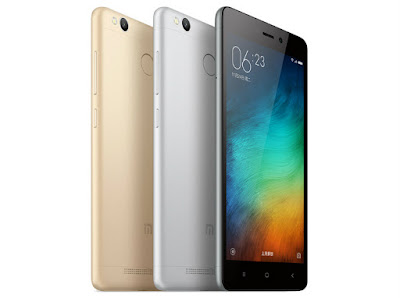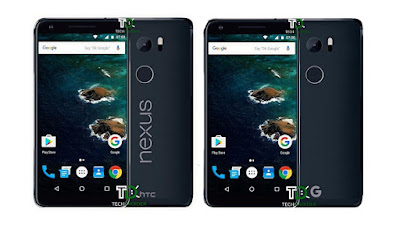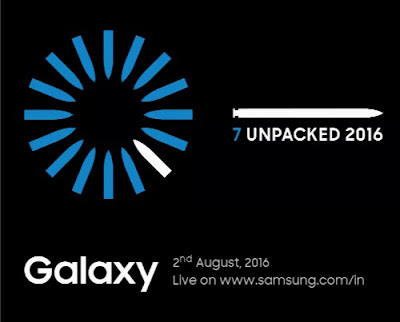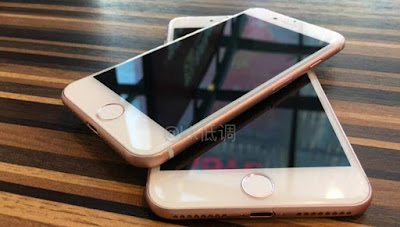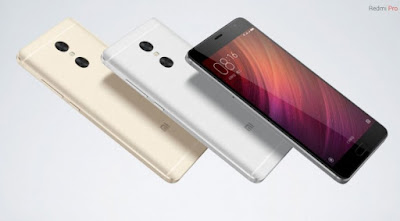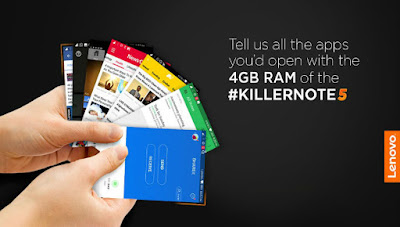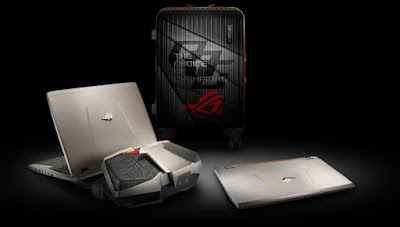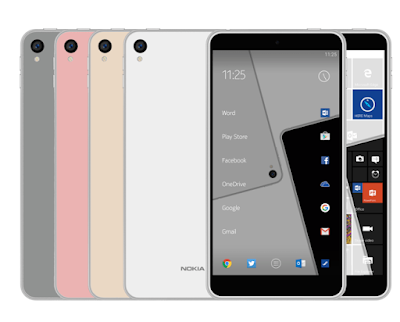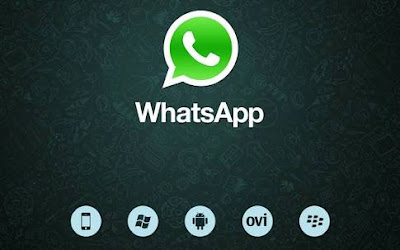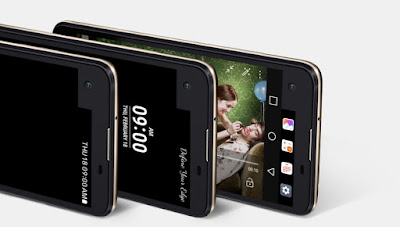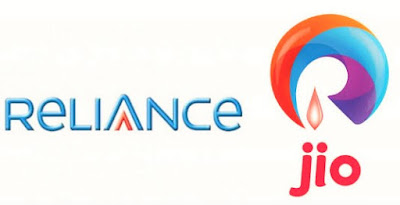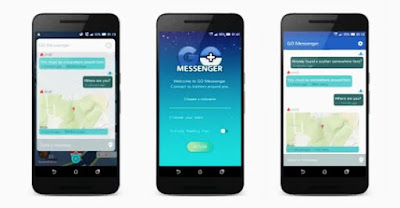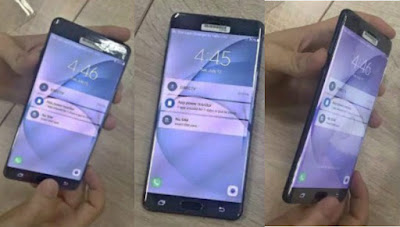Samsung
has made it official that it will unveil the Galaxy Note7 phablet on
August 2. The event, called ’7 Unpacked 2016′ is scheduled to kick off on August 2 at 11:00AM EDT in New York
or 8:30PM IST. Simultaneous launch events will also be taking place in London
and Rio de Janeiro. It is not just the date that Samsung has revealed, but it
has also talked about why the upcoming phablet will be called the Galaxy Note7,
and not the Galaxy Note 6. The
report further states that Samsung would be looking forward to market its
latest phablet and take the advantage of 2016 Rio Olympics, where Samsung is
one of the key sponsors.
Samsung
explains the reason behind the naming scheme in a blog post on its website — “First and
foremost though, you might be curious as to why it’s called
Galaxy Note7 instead of Galaxy Note 6. There are a couple reasons why. First,
the Galaxy Note7 will complement our
Galaxy S7 and S7 edge, and unify our product portfolio. Second, the Galaxy
Note7 will minimize confusion about the latest mobile technology from Samsung,
and provide full alignment with Galaxy S smartphone.”
Samsung’s Galaxy
Note7 has been in the rumor mills for quite some time now, and we already had a
fair idea about its name and a possible launch date. As the company explains,
by skipping a generation, it is bringing parity between the Galaxy Note and the
Galaxy S series.
Just a
few hours ago, we came across leaked live photos of the Galaxy Note7, showing
off the phablet from different angles. A handful of other leaked photos also
confirmed the presence of iris scanner for biometric authentication. Now, the
highly-anticipated Galaxy Note7 phablet has been certified by the FCC. Here’s a complete roundup of the rumored specifications and features that
we are likely to see in the Galaxy Note7.
Samsung
Galaxy Note 7 variants
With the
phablet closer to launch, Samsung has received FCC certification for six of
Galaxy Note7 models that are bound to be available with different carriers in
North America. These models include SM-N930P (Sprint), SM-N930W8 (Canada),
SM-N930V (Verizon), SM-N930T (T-Mobile), SM-N930A (AT&T) and SM-N930R4
(U.S. Cellular). While it doesn’t reveal any features and specifications, the certification does
mean that Samsung ready with the final version of the Galaxy Note7 for launch.
We can
see the front panel with the display, physical home button flanked with the
capacitive touch buttons and volume buttons on the left edge. Another photo
shows the top of the device with visible antenna lines, but similar to the
Galaxy S7 and Galaxy S7 edge, the IR blaster is missing from the Galaxy Note7
as well.
Samsung
Galaxy Note 7 features
Iris
scanner: Along with the lock pattern, password and fingerprint scanner, which
is embedded within the home button, the Galaxy Note7 will also include Iris
scanner for biometric authentication. French publication Nowhereelse has shared
some photos, which not only confirms the presence of iris scanner, but also shows
off how to set up the authentication feature. Samsung has already launched a
business focused tablet in India called “Galaxy Tab IRIS” which brings the iris scanner technology for authentication.
To begin
with, users will have to provide an alternative method (pattern lock) to unlock
the phablet. During the first setup, users will have to place the phablet at a
length of 25-35 cm away from their face, and of course, the screen facing
towards them. For the proper iris recognition, users will have to point their
eyes towards the two circles on the display. While iris scanner feature is a
welcome feature for added level of security, it remains to be seen if it will
also allow for Google Play Store purchase and third-party app support like
fingerprint sensors.
Waterproofing:
Similar to the Galaxy S7 and Galaxy S7 edge, the Galaxy Note7 is also expected
to sport IP68 certification for water and dust resistance. The certification
means that the phablet can be submerged in up to 1.5meter water for up to 30
minutes.
Improved
S Pen functions: The S Pen stylus is also rumored to come with a slightly
improved design. The Galaxy Note 5 had an issue, where inserting the S Pen
incorrectly could jam the stylus inside. To ensure that doesn’t happen,
Samsung could also redesign the slot on the Galaxy Note7.
Speaking
to Korea Herald, Samsung Mobile’s President, Koh Dong-jin confirmed that the new Note phablet will
come with improved S Pen functions. ”We have
improved ‘note’ functions this time, upgrading software for user convenience. We
should compete with our own competitiveness. The most important thing is
finding our own way that is well accepted by customers,” he said.
Operating
System: Earlier rumors pointed that the Galaxy Note7 could be launched sometime
in July and run Android Nougat out-of-the-box. However, considering that
Android Nougat is still in developer beta phase, the Galaxy Note7 may run
Android Marshmallow, and will later be updated to Android N. One of the Galaxy
Note7 variants was recently spotted running unreleased Android 6.1 version.
Now, it could be an incremental version with bug fixes or thin chances are such
where Google may name Android Nougat version as 6.1.
Like
always, the Galaxy Note7 will run on a layer of TouchWiz UI above Android OS.
Recently, a revamped version of TouchWiz UI video surfaced online, offering a
glimpse at it. From what we can see, the interface looks simpler, cleaner and
visually appealing. The quick toggle buttons have become flatter, settings menu
has new icons and single tab to access and change settings. You could also add
blur effects to widgets to increase or decrease the opacity based on your
needs.
Samsung
Galaxy Note7 specifications
Display:
Based on the recently leaked photos that we’ve come across, Samsung
will continue with the metal frame and glass display. As rumored, the leaked
photos also show off dual-edge curved display on the front. Some rumors also
suggest that a Galaxy Note7 variant with flat display may also be there. From
what we’ve come across, it could feature a Super AMOLED QHD display
between 5.7-inches and 6-inches in size.
Processor
and RAM: Now, here’s a bit of confusion. Earlier rumors pointed to Qualcomm’s
Snapdragon 823 chipset with 6GB of RAM. However, according to the data logged
in the recent benchmark listings, all the alleged Galaxy Note7 variants were
spotted running on 4GB of RAM. While 4GB
of RAM is more than enough, it remains to be seen if the final Galaxy Note7
comes with 4GB or 6GB of RAM.
On the
processor front, while some devices were powered by Snapdragon 820 chipset, a
couple of them ran on Samsung’s homebrew Exynos 8893 chipset, which is expected to be slightly
upgraded version of Exynos 8890 that powers the Galaxy S7 and Galaxy S7 edge.
Recently, Qualcomm unveiled the Snapdragon 821 chipset, which comes with a
slightly overclocked processor and minor improvements. There are chances
wherein, the Galaxy Note7 could ultimately be powered by Snapdragon 821 chipset
in some regions, and Exynos 8893 in other regions. Going by history, India
would likely get the Exynos version.
Storage:
All the Galaxy Note7 phablets spotted in benchmarks so far had 64GB of onboard
storage. However, rumors also point at 128GB and 256GB storage variants, and it
remains to be seen Samsung unveils them.
Cameras:
The cameras on the Samsung Galaxy S7 and Galaxy S7 edge have been praised a
lot. In our review and camera shootout between the high-end flagship
smartphones, we’ve seen the Galaxy S7’s 12-megapixel camera with dual-pixel technology outperform the
competition. And Samsung may use the same camera module on the Galaxy Note7 as
well. There are also other rumors doing rounds that the Galaxy Note7 could
employ dual-camera setup at the back, but we will have to wait and see if
Samsung goes ahead with it, or keeps it for the Galaxy S8.
Connectivity:
The Galaxy Note7 could be Samsung’s first device to come with the new USB Type-C port for data
transfer and charging. Being a reversible connector, you don’t need to
worry about which side is upside down, while plugging in. Another advantage of
USB Type-C is that it brings faster data transfer speeds.
Battery:
Rumors point to a 3,600mAh or 4,000mAh battery on the Galaxy Note7. It is also
expected to come with fast charging and wireless fast charging feature, just
like the Galaxy S7 and Galaxy S7 edge.
Samsung
Galaxy Note7 Price
The
Galaxy Note7 is expected to be priced around €849, which is approximately
Rs 63,000. This is quite higher compared to the Galaxy Note 5, which was
launched for Rs 53,900.
